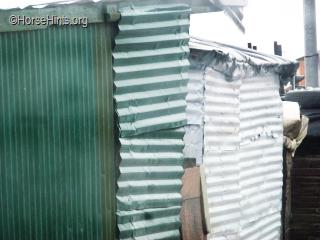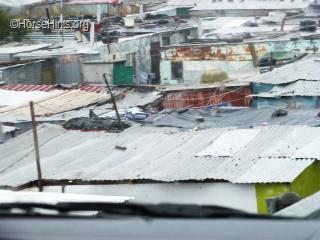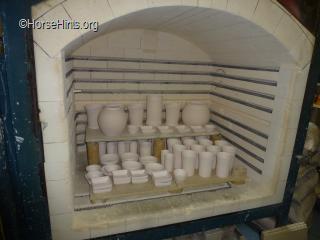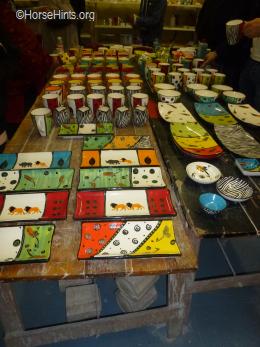
Soweto-Reconstruction and Development Programme Housing
While in Cape Town and Johannesburg we visited several shanty towns. Areas of Soweto, Johannesburg, are well known. In Cape Town, we visited a shanty town in the Lango District. Below are some pictures that I was able to take during those visits:



Shanty towns sometimes have an active informal economy, such as garbage sorting, pottery making, textiles, and leather works. This allows the poor to earn an income.



 "A shanty Town or squatter area is a settlement of improvised housing, called shanties or shacks, made of plywood, corrugated metal, sheets of plastic, and cardboard boxes. Such settlements are usually found on the periphery of cities, in public parks, or near railroad tracks, rivers, lagoons or city trash dump sites. Sometimes called a squatter, informal or spontaneous settlement, a typical shanty town often lacks proper sanitation, safe water supply, electricity, hygienic streets, or other basic human necessities. Shanty towns are mostly found in developing nations, but also in some parts of developed nations. Shanty is probably from Canadian French chantier, a winter station established for the organization of lumberjacks. Another possible derivation is from the Irish language sean tí meaning old house. Hutment means an 'encampment of huts'. When the term is used by the military, it means 'temporary living quarters specially built by the army for soldiers'. The term is also a synonym for shanty town, particularly in developing countries.
"A shanty Town or squatter area is a settlement of improvised housing, called shanties or shacks, made of plywood, corrugated metal, sheets of plastic, and cardboard boxes. Such settlements are usually found on the periphery of cities, in public parks, or near railroad tracks, rivers, lagoons or city trash dump sites. Sometimes called a squatter, informal or spontaneous settlement, a typical shanty town often lacks proper sanitation, safe water supply, electricity, hygienic streets, or other basic human necessities. Shanty towns are mostly found in developing nations, but also in some parts of developed nations. Shanty is probably from Canadian French chantier, a winter station established for the organization of lumberjacks. Another possible derivation is from the Irish language sean tí meaning old house. Hutment means an 'encampment of huts'. When the term is used by the military, it means 'temporary living quarters specially built by the army for soldiers'. The term is also a synonym for shanty town, particularly in developing countries.
Note: In the above picture at the beginning of the paragraph there was a small sleeping area that contained a television, a bed, and a tattered cloth upholstered chair that was stacked with all kinds of stuff. There was only one bathroom for 15 people on the other side of the eating area. At night the eating area was turned into a sleeping quarters where the boys and men slept on the table and the floor. The rooms were musty, dark and dank. The living conditions looked to be quite difficult.
FeaturesShanty towns sometimes have an active informal economy, such as garbage sorting, pottery making, textiles, and leather works. This allows the poor to earn an income. ...Since construction is informal and unguided by urban planning, there is typically no formal street grid, house numbers, or named streets. Such settlements also lack some or all basic public services such as a sewage network, electricity, safe running water, rain water drainage, garbage removal, access to public transport, or insect and disease control services. Even if these resources are present, they are likely to be disorganized, unreliable, and poorly maintained. Shanty towns also tend to lack basic services present in more formally organized settlements, including policing, mail delivery, medical services, and fire fighting. Fires are a particular danger for shanty towns not only for the lack of fire fighting stations and the difficulty fire trucks have traversing the settlement in the absence of formal street grids, but also because of the high density of buildings and flammability of materials used in construction....
Shanty towns have high rates of crime, suicide, drug use, and disease. However, Swiss journalist Georg Gerster has noted...that 'squatter settlements [as opposed to slums], despite their unattractive building materials, may also be places of hope, scenes of a counter-culture, with an encouraging potential for change and a strong upward impetus'. Stewart Brand has also written, more recently, that 'squatter cities are Green. They have maximum density-a million people per square mile in Mumbai-and minimum energy and material use. People get around by foot, bicycle, rickshaw, or the universal shared taxi ... Not everything is efficient in the slums, though. ...in most slums recycling is literally a way of life.'"

A shanty town near Cape Town, South Africa.
These slums were built by the apartheid era government to segregate people by color and ethnic origin. The above Khayelitsha Township is Africa's largest, with shanty homes served with disorganized electrical lines, with one shed showing a car parked inside.
Developing CountriesShanty towns are present in a number of countries. The largest shanty town in Asia is Orangi in Karachi, Pakistan. In francophone countries, shanty towns are referred to as bidonvilles (French for 'can town' - can being a reference to tin metal); such countries include Tunisia and Haiti. Other countries with shanty towns include South Africa (where they are often called Townships) or imijondolo, Kenya (including the Kibera and Mathare slums), the Philippines (often called squatter areas), Venezuela (where they are known as barrios), Brazil (favelas), Argentina (villas miseria), West Indies such as Jamaica and Trinidad and Tobago (where they are known as shanty towns), and Peru (where they are known as 'young towns'). In Russia, shanty towns - called truscóba - are present in smaller cities as well in Chelobityevo outside Moscow. There is also a major shanty town population in countries such as Bangladesh, and the People's Republic of China. ...
While most shanty towns begin as precarious establishments haphazardly thrown together without basic social and civil services, over time, some have undergone a certain amount of development. Often the residents themselves are responsible for the major improvements. Community organizations sometimes working alongside NGOs, private companies, and the government, set up connections to the municipal water supply, pave roads, and build local schools. Some of these shanties have become middle class suburbs. ...Development occurs over a long period of time and newer towns still lack basic services. Nevertheless, there has been a general trend whereby shanties undergo gradual improvements, rather than relocation to even more distant parts of a metropolis and replacement by gated communities constructed over their ruins. Many shanty towns are starting to implement the use of composting toilets and solar panels, and many of the people living in slums may have access to cell phones and even the internet. However, in spite of all this, inequality associated with shanty towns has only increased over time.
Joe Slovo is an informal settlement in Langa, Cape Town. Like many other informal settlements, it was named after former housing minister and Anti-Apartheid activist, Joe Slovo. With over 20,000 residents, Joe Slovo is one of the largest informal settlements in South Africa. While residents have been fighting for 15 years for their right to live in Langa, the settlement recently came into prominence when it began to oppose the national pilot housing project of Lindiwe Sisulu called The N2 Gateway.
Residents have opposed the government's request that they be forcibly removed to Delft, a new township on the outskirts of the city. After a High Court ruling by controversial judge John Hlophe in favor of the Government, many experts in constitutional law have claimed the ruling to be unjust and against the South African Constitution.
Since then, residents have appealed the decision and taken it to the South African Constitutional Court. In August 2008, about 200 Joe Slovo residents travelled by train, spent the night at the Methodist Church in Braamfontein, and arrived at the Constitutional Court to protest proposed evictions. They were accompanied in solidarity by the Anti-Eviction Campaign as well as residents from Symphony Way, an informal settlement that is also in conflict with the government over the N2 Gateway Housing Project.
The Centre on Housing Rights and Evictions and the Community Law Centre from the University of Cape Town, who joined the case as friends of the court, argue that the mass relocation will significantly impact resident's quality of life. During the case, constitutional court judges expressed concern over ![]() Judge John Hlophe's High Court ruling. Still, judgment has been reserved.
Judge John Hlophe's High Court ruling. Still, judgment has been reserved.
For More Information:
O'Malley The Heart of Hope